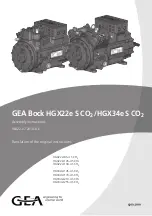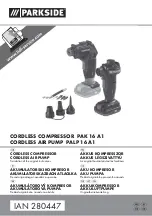
OPERATION CONTROLS
AIR COMPRESSOR PUMP.
To compress air, the piston moves up and down in the cylinder. On
the downstroke, air is drawn in through the intake valves. The exhaust valves remain closed. On
the upstroke of the piston, air is compressed. The intake valves close and compressed air is forced
out through the exhaust valves.
CHECK VALVE (A) FIG.3.
When the air compressor is operating, the check valve is “open”,
allowing compressed air to enter the air tank. When the air compressor reaches “Cut-Out”
pressure, the check valve “closes”, allowing air pressure to remain inside the air tank.
ON/AUTO-OFF SWITCH (C) FIG.5.
Turn this switch ON to provide power to the automatic
pressure switch and OFF to remove power at the end of each use.
PRESSURE SWITCH (D) FIG.5.
The pressure switch automatically starts the motor when the tank
pressure drops below the factory set “Cut-In” pressure. It also stops the motor when the air tank
pressure reaches the factory set “Cut-Out” pressure.
REGULATOR (E) FIG.5.
The air pressure coming from the air tank is controlled by the regulator.
Lift the regulator knob to unlock it and then turn it clockwise to increase pressure and counterclock-
wise to decrease pressure, push bouton down to relock it into position. To avoid minor
readjustment after making a change in the pressure setting, always approach the desired pressure
from a lower pressure. When reducing from a higher to a lower setting, first reduce the pressure
less than that desired, then bring it up to the desired pressure. Depending on the air requirements
of each particular accessory, the outlet regulated air pressure may have to be adjusted while
operating the accessory.
OUTLET PRESSURE GAUGE (F) FIG.5.
The outlet pressure gauge indicates the air pressure
available at the outlet side of the regulator. The pressure is controlled by the regulator and is always
less than or equal to the tank pressure.
TANK PRESSURE GAUGE (G) FIG. 5.
The tank pressure gauge indicates the air pressure in the tank.
COOLING SYSTEM.
This compressor contains an advanced design cooling system. The cooling
system is working when air is being expelled.
DRAIN VALVE (B) FIG. 4.
The drain valve is located at the bottom center of the air tank and is
used to drain condensation from the tank at the end of each use.
MOTOR THERMAL OVERLOAD PROTECTOR (RESET (I) FIG. 6).
The electric motor has an
automatic thermal overload protector. If the motor overheats for any reason, the thermal overload
protector will shut off the motor. The motor must be allowed to cool before restarting. Press the
reset button (I) after 15 minutes.
PRESSURE RELEASE VALVE.
The pressure release valve located on the side of the pressure
switch, is designed to automatically release compressed air from the compressor head and the
outlet tube when the air compressor reaches “cut-out” pressure or is shut off. The pressure release
valve allows the motor to restart freely. When the motor stops running, air will be heard escaping
from this valve for a few seconds. No air should be heard leaking when the motor is running, or
continuous leaking after unit reaches “cut-out” pressure.
SAFETY VALVE (H) FIG. 5.
If the pressure switch does not shut off the air compressor at its cutout
pressure setting, this safety valve will protect against high pressure by “popping out” at its factory
set pressure (slightly higher than the pressure switch cut-out setting).
WARNING!
: If the safety valve does not work properly, over pressurization may occur, causing air
tank rupture or an explosion. Daily pull the ring on the safety valve to make sure that the safety
valve operates freely. If the valve is stuck or does not operate smoothly, it must be replaced with
the same type of valve.
WATER FILTER (J) FIG. 5.
The water filter allows you to drain water periodically based on the
amount of condensation which forms. Pull down on the drain valve (K) Fig.5 to drain water from the
water filter.
Warning!
Do not pull drain valve while tank is under pressure or else risk of projectile.
FIGURE 3
FIGURE 4
FIGURE 5
FIGURE 6

























